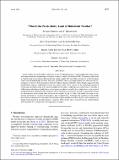What is the predictability limit of midlatitude weather?
Author(s)
Emanuel, Kerry Andrew
DownloadPublished version (2.723Mb)
Publisher Policy
Publisher Policy
Article is made available in accordance with the publisher's policy and may be subject to US copyright law. Please refer to the publisher's site for terms of use.
Terms of use
Metadata
Show full item recordAbstract
© 2019 American Meteorological Society. Understanding the predictability limit of day-to-day weather phenomena such as midlatitude winter storms and summer monsoonal rainstorms is crucial to numerical weather prediction (NWP). This predictability limit is studied using unprecedented high-resolution global models with ensemble experiments of the European Centre for Medium-Range Weather Forecasts (ECMWF; 9-km operational model) and identical-twin experiments of the U.S. Next-Generation Global Prediction System (NGGPS; 3 km). Results suggest that the predictability limit for midlatitude weather may indeed exist and is intrinsic to the underlying dynamical system and instabilities even if the forecast model and the initial conditions are nearly perfect. Currently, a skillful forecast lead time of midlatitude instantaneous weather is around 10 days, which serves as the practical predictability limit. Reducing the current-day initial-condition uncertainty by an order of magnitude extends the deterministic forecast lead times of day-to-day weather by up to 5 days, with much less scope for improving prediction of small-scale phenomena like thunderstorms. Achieving this additional predictability limit can have enormous socioeconomic benefits but requires coordinated efforts by the entire community to design better numerical weather models, to improve observations, and to make better use of observations with advanced data assimilation and computing techniques.
Date issued
2019-04Department
Massachusetts Institute of Technology. Department of Earth, Atmospheric, and Planetary Sciences; Lorenz Center (Massachusetts Institute of Technology)Journal
Journal of the atmospheric sciences
Publisher
American Meteorological Society
Citation
Zhang, Fuqing, et al., "What is the predictability limit of midlatitude weather?" Journal of the atmospheric sciences 76, 4 (April 2019): p. 1077-91 doi 10.1175/JAS-D-18-0269.1 ©2019 Author(s)
Version: Final published version
ISSN
0022-4928
1520-0469